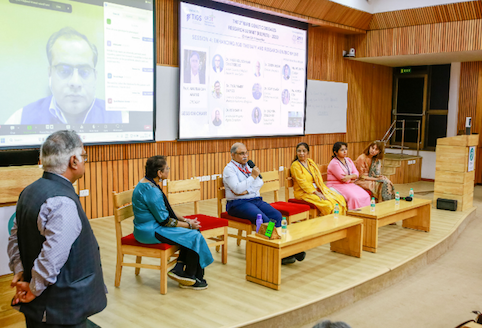Research, Innovation, and Hope for Genetic Diseases
March 05, 2024 | Tuesday | Features | By Esha Srivastava and Saveetha Meganathan
Need for robust investments in science and technology
A vibrant group of experts delved into the challenges and opportunities in developing effective therapies and diagnostics for Rare Genetic Diseases (RGD) at the session on “Enhancing RGD Therapy and Research Environment”.
Dr Taslim ignited the discussion, emphasizing the transformative power of innovation in delivering both therapeutics and diagnostics for RGDs. He stressed the crucial role of evidence-based research, urging its translation into tangible social impact. He also highlighted the need for robust investments in science and technology, nurturing a virtuous cycle of good science fueling further advancements.
Intellectual property rights expert Dr Rita Sarin shed light on the financial hurdles hindering RGD drug development. She explained the lengthy, expensive process of creating a drug molecule, a major deterrent for pharmaceutical companies due to low returns. She delved into the intricacies of licensing and various patent types, emphasizing the healthcare industry's focus on primary patents due to limitations on secondary patents in India.
Dr Sarin also showcased inspiring examples of successful indigenous and generic medications, while proposing valuable solutions. These included integrating research pipelines and fostering collaborative research, paving the way for either industry-academia partnerships to drive innovation or affordable API (active pharmaceutical ingredient) supplies through collaborations between innovative firms and the Indian pharmaceutical sector.
Dr Jogin Desai brought the spotlight to retinitis pigmentosa, a rare congenital retinal disease. He highlighted the devastating consequences of undiagnosed cases due to insufficient data, stressing the societal costs of inaction. He advocated for integrating genetic insights into societal knowledge, laying the groundwork for a comprehensive understanding of these often-overlooked conditions. His concluding remarks focused on key areas for improvement, including:
- Establishing a robust regulatory framework and addressing cost concerns through a homegrown innovation ecosystem.
- Approving in vitro experiments for RGD research, potentially reducing dependence on animal models.
- Enabling GMP (Good Manufacturing Practices)-like production facilities.
- Developing both a validated safety model and a gene-agnostic model.
Dr Ajay Singh broadened the lens, emphasizing the need for a diverse RGD ecosystem encompassing investors, NGOs, manufacturers, researchers, industry players, and patient advocacy groups. He underscored the fact that a staggering 80% of diseases have a genetic component, highlighting the collective responsibility to tackle this widespread challenge.
Dr Sadhna Joglekar provided a global perspective, presenting a landscape study of advancements in rare disease drug research from 1950 to 2023. She underscored the significance of collaborative decision-making and incentivizing rare disease drug development. Recognizing the complexities in research planning and execution, she advocated for overcoming these hurdles to accelerate progress.
Dr Nabendu Chatterjee shed light on government initiatives through ICMR (Indian Council of Medical Research), outlining the various ways in which the government is supporting RGD research and addressing crucial gaps:
- Early diagnosis
- Epidemiological data collection
- Therapeutics availability and affordability
- Awareness and expertise development
- Dedicated research initiatives
To address the critical challenges of therapeutic availability and affordability, Dr Chatterjee suggested increasing grants, fostering collaboration, and strengthening networking efforts. He further elaborated on existing government initiatives such as genomics projects, networking between patient advocacy groups and other stakeholders, therapeutics development for inherited rare diseases, and the National Apex Committee: National Consortium for Research and Development on Therapeutics in Rare Diseases (NCRDTRD). He concluded by outlining potential future directions, including prioritizing early diagnosis, developing novel or indigenous treatments, establishing a national registry, and characterizing rare diseases in the Indian context.
The latter part of the event resonated with personal stories from patient advocacy groups. Moumita Ghosh of the Cure SMA Foundation of India shared the heart-wrenching journey of her daughter with SMA (Spinal Muscular Atrophy), highlighting the struggles in accessing proper care and treatment. She spoke passionately about the organization's mission and how they support individuals with SMA. Kritida Oza, living with Sjogren's disease, shared her experiences and the challenges faced by patients with this rheumatic condition for which no specific therapy exists. Her plea for equal opportunities and acknowledging patients' perspectives added a powerful human touch to the discussion.
The event offered a potent mix of expert insights and lived experiences, illuminating the path towards a brighter future for those living with RGDs in India. By fostering collaboration, innovation, and a supportive ecosystem, we can ensure that no one is left behind in the quest for effective therapies and a better quality of life.
Esha Srivastava and Saveetha Meganathan
Click here to read the next article on REDRESS 2023









